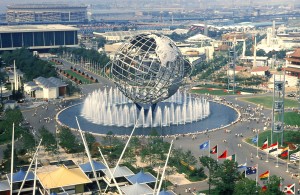NEW YORK — Fifty years ago, the World’s Fair opened in New York.
The Fair, a grand expo of technology, commerce, and cultures, was held in at a time when America’s fortunes were riding high in the post-war era. Now every time I pass the great Unisphere Globe, build by U.S. Steel and still standing proudly, I ask myself, “will anyone remember to commemorate the 1964 World’s Fair?”
Well the Queens Botanical Garden answered by hosting an Orchid exhibit from Taiwan. The Gardens were originally designed for the first World’s Fair in 1939-1940; that event was soon overshadowed by WWII. Though the 1964-1965 World’s Fair was expected to mark a time of celebratory optimism, the expo was also overtaken by the darkening clouds of the Vietnam conflict , and what would be a tumultuous decade.

Significantly the Republic of China on Taiwan was the first nation to break ground in Flushing Meadows, Queens for its national Pavilion. Taipei’s delegate in New York, Ambassador Paul Chang stated, “The theme of the ’64 World’s Fair, ‘Peace Through Understanding’ remains as valid and powerful as it was in 1964.”
While Ambassador Chang spoke of sub-tropical Taiwan as a “Kingdom of Orchids,” my mind drifted back to visiting the old Taiwan Pavilion, a grand and ornate four story Palace which remained a signature structure among the national pavilions.
The Vatican hosted Michelangelo’s venerable Pieta statue, the Belgian Village, medieval as it was, introduced Belgian Waffles, and The Kingdom of Jordan showcased the Dead Sea Scrolls. What kid wouldn’t like this?
But I must confess that the East Asian pavilions intrigued me most and played a subliminal if not strong role in my subsequent academic interests in the Far East.
Besides the technology (Bell Telephone’s high tech push button Princess phones!) and a Pepsi pavilion with the UNICEF ‘Small Small World Theme” song, I particularly enjoyed the international pavilions.
So let me recall the Fair from a slightly less nostalgic angle, recalling some of the Asian countries exhibiting then, but more importantly how these countries fared on the socio/economic graph now a half century later.
I start with Taiwan. The ornate pavilion encompassed both traditional and contemporary Chinese culture. Back in 1964, Taiwan was emerging from the chaos of WWII, but fast building itself into a prosperous and free market oriented island; what would later emerge as one of the Dragons of the Far East.
Taiwan was still agriculturally dependent, but having emerged from a successful land reform process, hosted a growing export oriented economy. Taiwan’s per capita income in 1964 was about $202 today it exceeds $20,000.
More importantly the ROC on Taiwan was a repository of Chinese culture, this at a time when the Mainland under Mao was trying to force traditional Chinese culture into a socialist cookie mold. Moreover, the People’s Republic still had frosty ties with Washington and thus was not at the Fair (and likely not welcome either).
Indonesia was another favorite of mine. Sadly the Indonesian archipelago was in the throes of Sukarno’s socialist revolution. Sukarno’s high octane nationalism and “non aligned” political stance, had alienated the Jakarta government from much of the world. But the batik and puppets were still a hit. Back then, Indonesia’s per capita was a meager $50 per year; today it exceeds $3,500.
South Korea boasted an Asian teahouse, showcasing products from this newly industrializing country. In the 1960’s, South Korea was led by the iron-fisted military strongman, Park Chung-Hee; a man credited with rebuilding the economy in the post- war era. Today his daughter Park Geun-Hye, is president of one of East Asia’s most vibrant democracies. Socio/economic progress has surged too from an anemic $121 in 1964 t o $22,400 today.
Japan’s pavilion presented a synthesis of the traditional and the modern ranging from the tea ceremony to space rockets. Besides showcasing the country’s vibrant industries, the expo exhibited models of the new high speed bullet trains. Recall that in 1964 Tokyo also successfully hosted the Olympics. In the early 1960’s Japan’s per capita income was $950; today it has reached an impressive $46,000.
There were other Asian pavilions too, Hong Kong, Malaysia, Thailand and the Philippines. These now forgotten World Fair pavilions presented countries whose phenomenal success today would hardly have been imagined a half century ago.
John J. Metzler is a U.N. correspondent covering diplomatic and defense issues. He writes weekly for WorldTribune.com. He is the author of Transatlantic Divide ; USA/Euroland Rift (University Press, 2010).


You must be logged in to post a comment Login